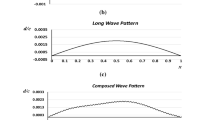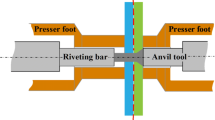Abstract
In aeronautical manufacturing, the assembly of large structures like wings and fuselages usually uses riveting to join the primary parts. The riveting process induces deformations between parts that affect aircraft performance and increase manufacturing costs. In this work, a finite element analysis of a rivet installation is developed to predict the induce deformations as a tool for the design of the assembly process in aeronautical industry. Different from the existing literature, which focuses mainly on fatigue analysis, the method presented in this paper focuses on finding a solution for determining induced deformations that can be applicable, from an industrial perspective, to aircraft production lines. A 2D axisymmetric model represents the installation of a single rivet joining two metal sheets with a force-controlled squeezing. The simplified model is proposed to reduce computational costs. An adaptive meshing scheme is adopted to better describe the forming of the driven head and improve the accuracy of the model. When comparing with existing methods, this attribute allows to better predict the profile of the radial expansion along the thickness of the sheets because the mesh is recalculated at each iteration to prevent distorted elements. Up to 18% relative difference was observed between the mesh with and without adaptive scheme. The results indicate that the radial expansion in the rivet hole is directly related to the squeeze force. An uneven expansion occurs through the thickness of the sheets indicating bending of the material. The mean radial expansion at half-pitch of 4 diameters was used to estimate the radial expansion of a rivet line composed of two or more rivets. The obtained results show that, for a rivet line composed of 50 rivets with a 4-diameter pitch (a panel with 952.5-mm length) the mean radial expansion for a 27.4-kN squeeze force is of 0.5 mm. It was also observed that the inner sheet (closest to the driven head) expands at least three times more than the outer sheet, indicating a bending mechanism is present in the panel.


















Similar content being viewed by others
Abbreviations
- D :
-
Diameter of the driven head
- D 0 :
-
Initial diameter of the rivet shank
- D max :
-
Maximum diameter of the driven head
- E :
-
Elasticity modulus
- H :
-
Height of the driven head
- K :
-
Strength coefficient
- n :
-
Strain hardening exponent
- n p :
-
Number of rivets in the junction line
- u r :
-
Radial expansion of a single rivet
- Y :
-
Rivet line expansion
- ν :
-
Poisson coefficient
- σ y :
-
Yield stress
References
Yoshizato A (2020) Prediction and minimization of excessive distortions and residual stresses in compliant assembled structures. 97p. Thesis (Master of Applied Science) - University of Victoria, Victoria
Rans C, Straznicky PV, Alderliesten R (2007) Riveting process induced residual stresses around solid rivets in mechanical joints. J Aircr. Available at: https://doi.org/10.2514/1.23684
Müller RPG (1995) An experimental and analytical investigation on the fatigue behaviour of fuselage riveted lap joints. 516p. Thesis (Doctor in Aerospace Engineering) - Delft University of Technology, Delft
da Cunha FRS, Figueira JAN, de Barros MC (2010) Methodology to capture induced strains on riveting process of aerospace structures. SAE Technical Papers. [S. l.: s. n.] Available at: https://doi.org/10.4271/2010-36-0016
Szolwinski MP, Farris TN (2000) Linking riveting process parameters to the fatigue performance of riveted aircraft structures. J Aircr. Available at: https://doi.org/10.2514/2.2572
Li G, Shi G (2004) Effect of the riveting process on the residual stress in fuselage lap joints. Can Aeronaut Space J 50(2):91–105
Li G, Shi G, Bellinger NC (2006) Study of the residual strain in lap joints. J Aircr. Available at: https://doi.org/10.2514/1.18125
De Rijck JJM (2005) Stress Analysis of Fatigue Cracks in Mechanically Fastened Joints: An analytical and experimental investigation. 302p. Thesis (Doctor in Aerospace Engineering) - Delft University of Technology, Delft
Figueira JAN (2014) Análise de deformações induzidas por rebitagem em estruturas aeronáuticas. 124p. Dissertation (M. Sc. in Aerospace Systems and Mechatronic) - Aeronautics Institute of Technology, São José dos Campos
Aman F et al (2013) Study of the impact of riveting sequence, rivet pitch, and gap between sheets on the quality of riveted lap joints using finite element method. Int J Adv Manuf Technol. Available at: https://doi.org/10.1007/s00170-012-4504-6
Abdelal GF et al (2015) Numerical and experimental investigation of aircraft panel deformations during riveting process. J Manuf Sci Eng Trans ASME. Available at: https://doi.org/10.1115/1.4028923
Zheng B, Yu H, Lai X (2017) Assembly deformation prediction of riveted panels by using equivalent mechanical model of riveting process. Int J Adv Manuf Technol. Available at: https://doi.org/10.1007/s00170-017-0262-9
Chang Z et al (2018) Prediction of riveting deformation for thin-walled structures using local-global finite element approach. Int J Adv Manuf Technol. Available at: https://doi.org/10.1007/s00170-018-2050-6
Li G, Shi G, Bellinger NC (2012) Assessing the riveting process and the quality of riveted joints in aerospace and other applications. Weld Join Aerosp Mater. [S. l.: s. n.]. E-book. Available at: https://doi.org/10.1533/9780857095169.2.179
Author information
Authors and Affiliations
Contributions
All authors contributed to the study conception and design. Material preparation, data collection, and analysis were performed by Carla Verônica Zanatta. The first draft of the manuscript was written by Carla Verônica Zanatta, and all authors commented on previous versions of the manuscript. All authors read and approved the final manuscript.
Corresponding author
Ethics declarations
Ethics approval
Not applicable.
Consent to participate
All authors consent to participate in this manuscript.
Consent for publication
All authors consent to publish this manuscript in the International Journal of Advanced Manufacturing Technology.
Competing interests
The authors declare no competing interest.
Additional information
Publisher's note
Springer Nature remains neutral with regard to jurisdictional claims in published maps and institutional affiliations.
Rights and permissions
About this article
Cite this article
Zanatta, C.V., Villani, E., de Mello, J.M.G. et al. Riveting process simulation to predict induced deformations in aeronautical structures. Int J Adv Manuf Technol 120, 7673–7687 (2022). https://doi.org/10.1007/s00170-022-09247-4
Received:
Accepted:
Published:
Issue Date:
DOI: https://doi.org/10.1007/s00170-022-09247-4




